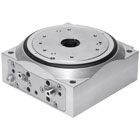Rotary Indexing Tables Information
 Rotary indexing tables are machine tool positioning devices used to index parts in defined, angular increments so that they can be machined or assembled. During operation, the table indexes around a central axis, stops at a predetermined location, dwells in that position while an operation is performed, and then indexes to the next position.
Rotary indexing tables are machine tool positioning devices used to index parts in defined, angular increments so that they can be machined or assembled. During operation, the table indexes around a central axis, stops at a predetermined location, dwells in that position while an operation is performed, and then indexes to the next position.
A typical rotary indexing table may consist of a circular steel plate, one or more spindles, a drive system, encoders, sensors, controllers, and slots or mounting holes used to hold components in place. Rotary indexing tables have either fixed or adjustable indexing angles. During each revolution, the table stops for a specified period of time so that an operation can be performed at each station. The bearings that support rotary indexing tables determine both the load capacity and accuracy. Angular contact bearings are more expensive than recirculating ball bearings, but provide better load capacity and axial stiffness. Cross-roller bearings are also commonly available.
Rotary indexing tables are powered by pneumatic and electric motors, hydraulic drives, and manual actuation. Drive mechanisms can be located above, below, behind, or to the side of the table surface. Pneumatic rotary indexing tables are suitable for small and medium loads. They are powered by one of more pneumatic cylinders, each of which represents an index. During the return stroke, a pawl locks the table in place. With some devices, the pawl can be adjusted to change the number of indexes. Electrically-powered tables are generally faster than pneumatic devices and can handle heavier loads. Tables that are powered by hydraulic drives use a pressurized fluid that transfers rotational kinetic energy. Manually-actuated rotary indexing tables often include a hand crank or are loosened, turned, and adjusted by hand.
Design World — "What is a Rotary Index Table?"
Specifications
Selecting rotary indexing tables requires an analysis of specifications and features.
Specifications include:
- maximum indexing increment
- work table diameter
- maximum axial load
- maximum radial load
Features
A variety of features are available. Some table surfaces can be raised or lowered at a controlled angle. Others have more than one rotating work surface. Computer numerically controlled (CNC) devices provide greater accuracy and repeatability. Rotary encoders are often used to relay the position of the table surface. Both four-axis tables and five-axis tables provide variable X, Y, and Z axis motion. Four-axis tables also provide part rotation along the X axis. Five-axis tables provide part rotation along both the X axis and the Y axis.
Applications
Applications for rotary indexing tables include assembly and equipment positioning, as well as various automation, inspection, and machining applications. Most devices work well with machines that perform fast and simple vertical operations. Examples include industrial presses, screwdrivers, riveters, dispensers, pick-and-place units, and ultrasonic or resistance welders. Parts can be loaded and unloaded manually or automatically.
